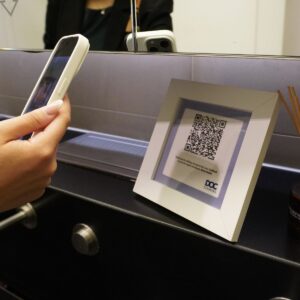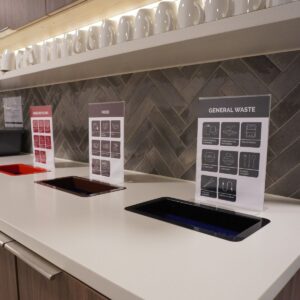Digital monitoring and IoT technology are transforming the way buildings are maintained — and heritage sites are no exception. When used responsibly, these tools can play a powerful role in protecting sensitive environments, optimising labour and improving overall site performance.
From real-time cleaning data to intelligent waste tracking, digital systems give facilities teams valuable insight that supports both operational efficiency and long-term preservation. For heritage sites, where environmental sensitivity and budget constraints often go hand-in-hand, the key is ensuring that any solution introduced is appropriate, efficient and justifiable.
Smarter Monitoring for Heritage Environments
Digital monitoring can offer powerful advantages in heritage cleaning, but only when applied with care and consideration for the unique demands of historic buildings.
Unlike commercial spaces, heritage environments require close control over factors like humidity, temperature and moisture. These conditions directly impact the long-term preservation of interior finishes and materials, which are often fragile, irreplaceable and historically significant.
Many heritage buildings are managed by charitable trusts or public bodies, often operating under tight financial constraints, and therefore any digital solution must deliver tangible, measurable benefits — not only in terms of operational efficiency, but also in terms of supporting conservation priorities and sustainable practice.
The most effective tools are those that support:
-
Interior preservation
-
Sustainability goals
-
Task and labour optimisation
-
Improved visitor and occupant experience
-
Reduced product and paper waste
Heritage sites require attention to detail on many aspects other buildings don’t – such as humidity, temperature fluctuations, and moisture – which contribute to long-term damage, or if done correctly, and preservation of historic interiors.
Research by Spica Technologies suggests that data-driven cleaning using IoT systems can reduce operational costs by up to 30%, by enabling more targeted, efficient deployment of cleaning teams. In heritage environments, this also means reducing unnecessary contact with delicate materials — helping to avoid the cumulative wear caused by over-cleaning or repeated chemical exposure.
Supporting this, a study by Cathedral Communications identified environmental fluctuations and minor, routine maintenance damage as two of the most common risks to historic interiors — both of which can be better managed through the use of real-time data and smart monitoring systems.
By implementing these tools responsibly, heritage sites can benefit from modern efficiencies without compromising the character or integrity of the spaces they protect.
Schedule Monitoring Systems
 Cleaning schedule systems can allow room for smart service requests based on real-time site conditions. On-site operatives can use these systems in and around the buidling during their working hours.
Cleaning schedule systems can allow room for smart service requests based on real-time site conditions. On-site operatives can use these systems in and around the buidling during their working hours.
Rather than on-site operatives following to a rigid schedule, tasks can be deployed where they deem most needed, minimising disruption to the site and preserving materials and visitor experience.
A great example of systems like these in practice is our work at the National Gallery. In conjunction with TAQT, we were able to implement IoT technology to coordinate cleaning tasks without interfering with the visitor journey or risking over-cleaning sensitive areas.
Waste Stream Monitoring Systems
 On the other hand of commercial cleaning technology, waste-stream monitoring systems, which can be used internally and externally on bin units, allow for intelligent tracking of recycling and waste disposal.
On the other hand of commercial cleaning technology, waste-stream monitoring systems, which can be used internally and externally on bin units, allow for intelligent tracking of recycling and waste disposal.
These systems provide detailed data on waste levels, recycling performance, and bin usage trends – helping to improve sustainability initiatives, reduce operational costs and maintain a cleaner, healthier environment.
Two effective systems which we currently have implemented on a number of our sites are Weightron and Nando. These platforms provide accurate monitoring and reporting of waste output, enabling operation teams to better manage volumes, increase recycling rates and reduce overall waste to landfill.
Key Benefits of Digital Monitoring in Heritage Settings
Digital monitoring and IoT tools offer a wide range of benefits when implemented thoughtfully in heritage environments.
From improved service delivery to greater preservation and sustainability, these systems can deliver both immediate and long-term value — provided they’re introduced with care and aligned with each site’s operational and conservation needs.
Enhanced Visitor Experience
In heritage settings, visitor experience is closely tied to how the space is managed – both visibly and behind the scenes. Digital monitoring systems help teams identify high-traffic areas and peak occupancy periods, allowing cleaning tasks to be scheduled around visitor flow.
By shifting tasks to lower-traffic periods, cleaning teams can minimise disruption and preserve the visual integrity of galleries, corridors or public spaces. This not only enhances the visitor journey but also reduces the risk of obstructing exhibits, events or guided tours.
Real-time insights help prevent overcrowding in sensitive areas, preserving temperature, humidity and air quality conditions that are crucial to conserving fragile interiors. The result is a smoother, safer and more enjoyable experience for every visitor, without compromising preservation efforts.
Improved Communication
Clear, consistent communication is key to managing cleaning operations in heritage environments — especially when teams are split across large sites or working in varied conditions.
With platforms like FacilityApps, communication becomes streamlined and traceable. Supervisors and operatives can send and receive messages, alerts and updates in real time. Whether it’s reporting an urgent task, confirming a schedule adjustment, or flagging a conservation concern, communication is centralised and no longer reliant on paper logs or in-person check-ins.
Beyond daily operations, these systems also support wider workforce management:
-
Leave requests
-
Attendance records
-
Payslip access
-
Document storage and training materials
For managers, the benefits include improved visibility, reduced duplication and faster access to compliance records — all of which support more responsive, paperless operations.
Reduced Risk of Damage
Preserving heritage interiors often means avoiding unnecessary contact with materials that degrade over time. Digital tools help reduce that risk by allowing cleaning teams to clean only when required, rather than on automatic, fixed schedules.
Detailed cleaning logs and real-time updates allow for traceability of every task, including who cleaned what, when and why. This supports better planning and creates defensible audit trails that help demonstrate a conservation-conscious approach.
Importantly, this limits operatives’ exposure to chemicals and repetitive strain, as tasks are assigned more precisely. Reducing unnecessary contact with surfaces lowers the cumulative risk of long-term damage to fragile finishes like wood, plaster, textiles and masonry.
Real-Time Data
One of the greatest advantages of digital monitoring is the ability to collect and act on real-time data. This can include occupancy levels, environmental readings and cleaning performance — all of which help site managers make informed decisions in the moment, not just in hindsight.
For multi-use spaces or large properties, this level of granularity ensures that no area is overlooked, and resources are deployed where they’re needed most. For example:
-
Frequently used spaces can be flagged for increased attention
-
Underused areas can be maintained less frequently, saving time and materials
-
Trends can be identified and used to guide longer-term resourcing or layout adjustments
Over time, this supports continuous improvement, helping cleaning teams deliver smarter, faster and more focused service.
Our Approach to Responsible Innovation
We understand that heritage sites require more than just standard cleaning services. With more than 50 years of professional experience within the heritage sector, we can provide a strategic, respectful and data-informed approach.
To find out how we can enhance your building, get in touch with our friendly support team today. You can give us a call on 01279 944332 or email helpdesk@doccleaning.com.
